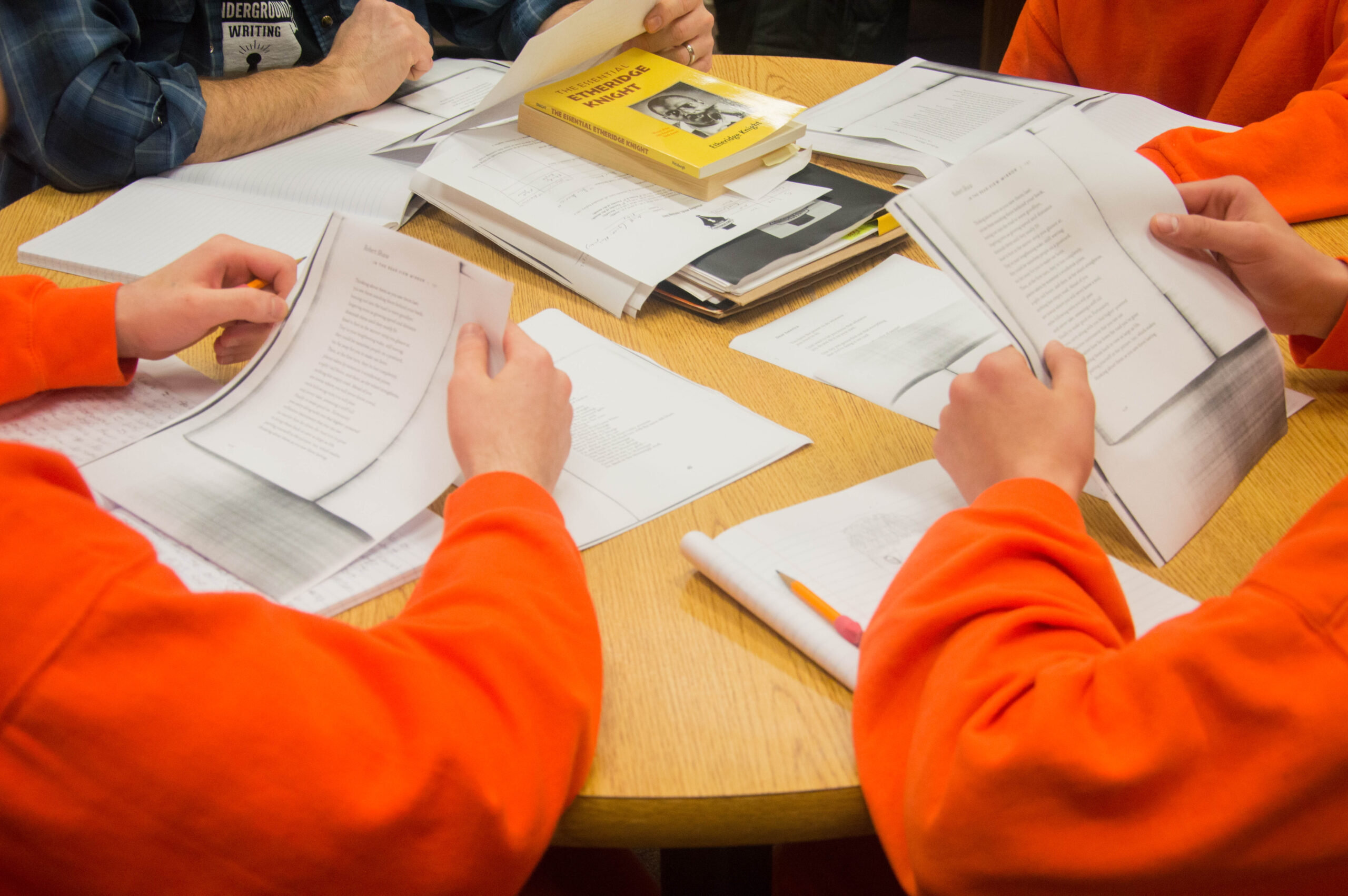Bechtel Prize Judge Garth Greenwell selected Reagan Ross’ essay “Write Your Own Lord of the Flies with Dyslexia: \/尺⌽┻𝝣 7≠レ尺 ≠⌴乙 レ≠尺⌴ ≠𝞝 ┻冊𝝣 𝞝レ⌽3” as the 2024 Bechtel Prize honorable mention. The Bechtel Prize is awarded for an essay describing a creative writing teaching experience, project, or activity that demonstrates innovation in creative writing instruction.
The Bechtel Prize is named for Louise Seaman Bechtel, who was an editor, author, collector of children’s books, and teacher. She was the first person to head a juvenile book department at an American publishing house. As such, she took children’s literature seriously, helped establish the field, and was a tireless advocate for the importance of literature in kids’ lives.This award honors her legacy. Learn more about the Bechtel Prize here.
It’s winter quarter at Rembrandt School for the Arts and Sciences, a learning academy for neurodivergent teenagers, and I am asking students to imagine eating their friends.
As a learning specialist, I help high school students with social, emotional, and academic skills. I’ve known these particular students since eighth grade. We’ve gone through sex education, drugs and alcohol education, To Kill A Mockingbird, and the Civil War together. They’re sophomores now and studying Lord of the Flies.
The prompt is simple: Write your own version of Lord of the Flies. Use yourself and your classmates as characters. No word limit. You have three weeks.
Just one problem: my students have dyslexia, and writing causes them tremendous anxiety. Some have been told by teachers that they can’t read, let alone write original fiction.
The prompt is simple. . . . Just one problem: my students have dyslexia, and writing causes them tremendous anxiety.
I know how hard reading is for my students because of Rembrandt’s annual learning symposium. Each year, Rembrandt hosts a community education effort to teach neurotypical folks about neurodiversity. The symbols in this title are a combination of codes from the primer we use in the dyslexia simulator and Daniel Britton’s dyslexia typographic design, which removes 40% of a Helvetica letter. It gives some idea of what reading with dyslexia feels like. People with dyslexia use complex decoding methods to aid their visual processing, which often leads to slower reading times compared with neurotypical students. Before widespread use of the clinical term, educators and psychologists called dyslexia a “reading disability.”
It absolutely crushes me when I hear a kid say “I can’t read,” words they no doubt heard from a parent, educator, adult, or peer who didn’t understand their learning difference. Even though they can’t read like a person without dyslexia, they absolutely can read.
“You can read,” I tell them.
“We can’t write, though,” they say.
As my students crack jokes and tell stories in my classroom, I assure them that if they can tell a story, they can absolutely write one.
Let’s meet the class!
We have Lana, a musical genius who spent whole months of eighth grade sitting under a desk because of shyness. We have Alex, who finds lots of ways to humorize the fact that his dad left him and his mom. We have Jason, whose dad controls his every move. We have Jacee, who loves Gray’s Anatomy, and Dr. Pimple Popper dreams of becoming a surgeon, but her dad thinks her dyslexia means she can’t get into medical school. On top of their learning differences, these students also have to deal with teen horrors like puberty, eating disorders, cyberbullying, and depression.
Luckily, none have ever seriously considered cannibalism.
On top of their learning differences, these students also have to deal with teen horrors like puberty, eating disorders, cyberbullying, and depression. Luckily, none have ever seriously considered cannibalism.
First, we read Lord of the Flies out loud.
There’s a reason “story time” trends on TikTok; there’s something truly magical about reading out loud to a group. Oral tradition is one of humanity’s greatest spells.
Reading out loud is by far my favorite part of my job. Because dyslexia affects visual processing, I scaffold using auditory processes like listening and speaking. Time, attention spans, and academic independence dictate that I do not read the ENTIRE book out loud, but I read as much out loud as I can. I emphasize words that might provide context clues and put lots of emotion in my voice, making the dark story lurch to life. I do voices for the characters. After a few chapters, the students get sick of my voice and want to voice the characters themselves. They volunteer to read dialogue, then whole paragraphs. Lana loves the detail that the kids are British and reads Ralph with a Harry Styles-inspired accent. Can you imagine reading with dyslexia AND a foreign accent? It’s pretty tough. But the kids wait patiently for her to fumble through it and then ask politely to read independently.
Soon, the students become highly invested in treating Lord of the Flies like a slasher movie.
“Well why did they do it THAT way? Why don’t they just >INSERT OBVIOUS 21st CENTURY HACK FOR ESCAPING DESERT ISLAND HERE<??”
“Put it in your own story,” I tell them.
Reading a good story also teaches us how to tell a good story. I increasingly think of human brains as large language models. I believe if you consume good writing, you’ll write well. Luckily, Lord of the Flies holds up.
Next, we write.
We begin with a group brainstorm, followed by a pen-to-paper brainstorm of words, pictures, and colors, which we then organize into mind maps. Next, I work one-on-one with the students on their first drafts. We use assistive technologies like talk-to-text, Siri, and Grammarly. Educational technology has made great gains in the last 10 years. Students have more and more ways to turn spoken words into written ones. Still, I find that they need a safe space to experience dictation. Saying your thoughts out loud feels scary at first.
The students usually dictate their first few paragraphs to me. I type them out, then have the students read it back out loud so they can catch any errors. Eventually, they want more independence, and they transition to an assistive technology.
The beauty of letting a dyslexic student read their own work is this: they know exactly how it sounds in their head. The story is truly their own. Despite my insistence that nobody has to read out loud in front of a group, they all want to read their stories out loud. They shout out their tales, trying to make each other laugh with their hilarious versions of the class floundering around on a desert island.
The beauty of letting a dyslexic student read their own work is this: they know exactly how it sounds in their head. The story is truly their own.
There are no adults in Lord of the Flies. One must assume the presence of grown-ups would create a natural order and prevent cannibalism. And so, the first thing the kids do is kill their parents.
The students off their parents with hilarious irony. Jacee’s mom’s breast implants pop, releasing gas that blows up the airplane. Jason’s dad is the pilot of a private jet. He refuses to ask for directions and crash lands on the island. Lana spares her parents: as the plane goes down, her pilot says, “Maybe just call your mother and tell her you love her. You know, just in case.”
Jacee actually opts to kill herself and tell the story from heaven, Lovely Bones style. She asks if she can use her extended family instead of her classmates. I say yes. She uses the exercise to process her family’s quirks. The headstrong fathers lead everyone to doom. The innovative daughters escape the Dome of Doom (the title of her story), but in the end, everybody dies.
“Is it too violent?” she asked me.
I shrug. “Lord of the Flies is pretty violent,” I said.
My favorite line in her story comes when she thinks about how now that all her family is dead, she might see them in the afterlife, but since it’s heaven, she probably won’t. She writes:
I laughed so hard I threw up on a cloud. They were dead, yes, but they were all sitting in the waiting room while I was in my personalized paradise. Even if they do get sent up here with me, they might not be with me because they aren’t in my personalized paradise.
Youch.
In Alex’s story, he leaves the group and tries to survive on his own. In the end, he almost dies. It seems like his way of acknowledging that even though he plays it cool about being man of the house, he’s really still just a kid who wants someone to take care of him.
Lana’s story is called “Freaky Friday.” After the plane crash, the boys and girls swap bodies. The boys get their periods. The girls don’t know their own strength. Lana plays with perception as reality. She puts herself in the body of the tallest boy in school, and everyone starts treating her with respect. In the end, the students choreograph a group dance and get rescued by a cruise ship. In the end, it was all a dream.
Many students set up dream narratives or simulated realities to tell their stories. I always found that interesting. Why fictionalize fiction with a dream? I think the kids wanted to convey that even though they were writing outlandish things, they wanted to protect each other by removing their stories one step further from reality. If there’s one thing teenagers universally understand, it’s the surreal wasteland of wacky dreams. They make no sense!!
All in this together.
Curiously, in every story, the students either kill everyone or save everyone. All the stories center around working together to survive or failing to work together and perishing en masse. Even though the stories aren’t real, they evoke real emotions: compassion, empathy, community, the interconnectedness of people. They’re all in this together.
But no one’s really going to crash on a desert island, right? That would be preposterous!
Three months later, something preposterous does happen: a global pandemic. Despite gripes and groans from parents, the school shuts down.
For many students, this means losing a safe space. They are now trapped at home all day with the very parents they opted to write out of their stories. I dedicate at least 20 minutes of our 60-minute virtual class block to something that sparks joy. They flood my check-ins with “OMG YOU WON’T BELIEVE WHAT >FAMILY MEMBER< DID THIS TIME.”
Even though the stories aren’t real, they evoke real emotions: compassion, empathy, community, the interconnectedness of people. They’re all in this together.
The next 18 months prove difficult, but, like in their Lord of the Flies stories, the students lean on each other. They meet up for long walks outside. They plan elaborate trips to Target. They start book clubs (!!!). Eventually, I work a 100-word journal prompt into the weekly homework so they can express themselves without using up so much class time. After three months, I up the requirement to 250 words. When half the class starts writing 500 words unprompted, that becomes the benchmark. They hardly even need me to dictate anymore. Since school is basically 100% technology now, using assistive technology to write seems way less scary.
When everybody comes back to in person learning, it is, bafflingly, time to start thinking about college essays. Kids who once ran screaming at the prospect of writing about themselves come to me with heaps of personal essay ideas.
“Should I write about my grandma dying?” (Yes.)
“Should I write about the day in the life with my ADHD?” (Yes.)
“Should I write about how my uncle going to jail got me passionate about prison reform?” (YES!!!)
“Should I write about this crazy dream I had?” (No.)
For them, dyslexia hardly registered as a learning difference anymore. The students knew how to write about moments that changed them. They knew how to share their stories. Their practice of personal writing started with Write Your Own Lord of the Flies.
That spring, I chaperoned prom. They all danced in a big group, hands in the air, just like in Lana’s story. They rescued themselves, with writing.
Featured photo by sahil muhammed on Unsplash.
Reagan Ross
Reagan Ross is a writer and video essayist from Los Angeles, CA. A Teach for America alum, Reagan has worked in special education for 15 years. They are currently studying creative writing at UCLA and working on a YA novel. You can find their video essays on YouTube under Nats Can Fly.



